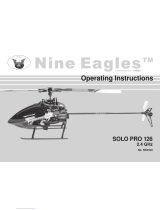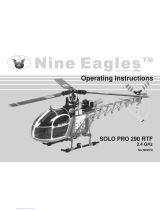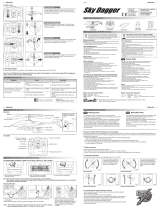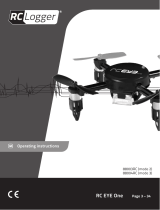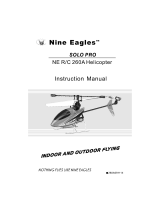Page is loading ...

Operating Instructions
BLUE ARROW
NANO LOOP RTF
2.4 GHz No. S2531

Contents Page
Explanation of specialist terms / Contents 2
Safety Notes 3, 4
Set contents / Specification / Recommended accessories 5
Transmitter description Mode 1 + 3 6
Transmitter description Mode 2 +4 7
Changing the transmitter throttle stick 8
Important assembly steps before the first flight 9
Receiver outputs 9
Transmitter LCD display 10
Transmitter settings 10, 11
Charging the battery / LiPo battery safety notes 12
Flight preparation normal and stunt modes 13
Trim adjustments in Mode 1 / Mode 2 14
Trim adjustments in Mode 3 / Mode 4 15
Controlling the model in Mode 1 / Mode 2 16
Controlling the model in Mode 3 / Mode 4 17
Important advice / The first few flights 18
Spare parts 19
Explanation of specialist terms:
Climb and descent ("Throttle/pitch"): This controls the
model's climb and descent.
Yaw: The model's movement around the vertical axis;
the helicopter rotates to right or left.
Elevator: The model's movement around the lateral
axis,
forward or reverse flight
Roll: The model's movement around the longitudinal
axis,
sideways movement to right or left
Mode 1: Function assignment of the control move-
ments relative to the stick movements.
In this case collective pitch / motor speed (throttle) and
roll are controlled by the right-hand stick; pitch-axis
and tail rotor by the left-hand stick.
Mode 2: Function assignment of the control move-
ments relative to the stick movements.
In this case collective pitch / motor speed (throttle) and
tail rotor are controlled by the left-hand stick; pitch-axis
and roll by the right-hand stick.
Dual Rate: Switchable travel reduction for control mo-
vements.
Binding
: Creating the radio link between transmitter
and receiver.
2
Operating Instructions,BLUE ARROW NANO LOOP 2.4 GHz No. S2531

Be sure to read these Safety Notes before you attempt to
fly your model. Always keep to the procedures and settings
recommended in the instructions.
If you are operating a radio-controlled model aircraft, heli-
copter, car or boat for the first time, we recommend that you
enlist an experienced modeller to help you.
Safety Notes
Radio-controlled models are not toys in the usual sense of the
term. Young persons under fourteen years should only be allo-
wed to operate them under the supervision of an adult.
Building and operating these models requires technical expertise,
manual skills, a careful attitude and safety-conscious behaviour.
Errors, negligence and omissions in building or flying these mo-
dels can result in serious personal injury and damage to property.
Since the manufacturer and vendor are not in a position to check
that your models are built and operated correctly, all we can do
is bring these hazards expressly to your attention. We deny all
further liability.
Helicopter rotors, and all moving parts generally,
constitute a constant injury hazard.
It is essential to avoid touching such parts.
Please bear in mind that motors and speed controllers
may become hot when operating.
It is essential to avoid touching such parts.
Do not stand close to the hazard area around rotating parts
when an electric motor is connected to the flight battery.
You must also take care to keep all other objects away
from moving or rotating parts.
Observe the instructions provided by the battery ma-
nufacturer.
Overcharged or incorrectly charged batteries may explo-
de. Take care to maintain correct polarity.
Notes on the use of dry cells:
Do not attempt to recharge dry cells, do not open them,
and do not incinerate them. Remove exhausted dry cells
from the transmitter after use. Escaped electrolyte may
ruin the transmitter.
Ensure the equipment is protected from dust, dirt and moisture
contamination. Do not subject the system to excessive heat, cold
or vibration.
Use the recommended charger only, and charge the batteries
only for the prescribed period.
Check your equipment for damage at regular intervals, and re-
place defective components with genuine spare parts.
Do not re-use any devices which have been damaged in a crash
or by water, even when they have dried out again.
Either send the equipment to the robbe Service Department for
checking, or replace the parts in question.
3
Operating Instructions,BLUE ARROW NANO LOOP 2.4 GHz No. S2531

Crash or water damage can result in concealed defects which
may lead to failure in subsequent use.
Use only those components and accessories which we specifi-
cally recommend.
Do not carry out modifications to the radio control system compo-
nents apart from those described in the instructions.
Operating the model
•Never y over or towards spectators or other pilots, and
maintain a safe distance from them at all times.
•Neverendangerpeopleoranimals.
•Neveryclosetohigh-tensionoverheadcablesorpopulated
areas.
•Donotoperateyourmodelinthevicinityofcanallocksoropen
waterways.
•Donotoperateyourmodelfrompublicroads,motorways,pa-
ths and squares etc.; use authorised model flying sites only.
• Never operate the model in stormy weather.
Never “point” the transmitter aerial straight at the model when
operating it. The transmitter signal is at its weakest in this di-
rection. It is always best to stand with the long side of the aerial
angled towards the model.
Insurance
Ground-based models are usually covered by standard personal
third-party insurance policies. In order to fly model aircraft you
will need to extend the cover of your existing policy, or take out
specific insurance.
Check your insurance policy and take out new cover where
necessary.
Liability Exclusion
robbe Modellsport is unable to ensure that you observe the as-
sembly and operating instructions, or the conditions and methods
used for installing, operating and maintaining the model compo-
nents.
For this reason we accept no liability for loss, damage or costs
which are due to the erroneous use and operation of our pro-
ducts, or are connected with such operation in any way.
Regardless of the legal argument employed, our obligation to
pay compensation is limited to the invoice value of those robbe
products directly involved in the event in which the damage oc-
curred, unless otherwise prescribed by law. This does not apply
if the company is deemed to have unlimited liability according to
statutory regulation due to deliberate or gross negligence.
4
Operating Instructions,BLUE ARROW NANO LOOP 2.4 GHz No. S2531

5
Dear customer,
Congratulations on choosing a factory-assembled mo-
del helicopter from our range. Many thanks for placing
your trust in us.
The model can be completed and made ready to fly
very quickly. Please read right through these instruc-
tions before attempting to fly the model for the first
time, as this will make it much easier to operate the
model safely.
All directions, such as “right-hand”, are as seen from
the tail of the model, looking forward.
Specification:
Ø Rotors: approx. 45.8 mm
Overall length: approx. 138 mm
Weight: approx. 30 g
Motors: 0720RN
Power supply: LiPo battery, 3.7 V / 240 mAh
Essential accessories:
8x 8008 Mignon Batteries Alkali Manganese AA
Recommended accessories:
8 x 8005 NiMH AA-cell, 1.2 V / 2500 mAh
1 x F1415 Transmitter charge lead
1x 8564 POWER PEAK
®
Uni 7 EQ 230V
Set contents:
1 x Mini-quadrocopter, completely assembled and set up, ready to fly
1 x Painted plastic canopy
4 x miniature drive motors (2 x right-hand, 2 x left-hand rotation)
2 x LiPo battery, 3.7 V / 240 mAh, 25 C, with polarised connector
1 x 5 V USB twin-output charger for simultaneous charging of both flight batteries
1 x Installed electronic motor control unit with integral receiver and 6 axis gyro
1x 2.4 GHz 4-channel computer transmitter XS-4 LCD Pro
(Mode 2 as standard, Modes 1 to 4 can be set)
1x Bind plug
1 x Screwdriver
1 x Comprehensive operating and flying instructions
Please be sure to observe the Safety Notes concerning
the handling of Lithium-Ion-Polymer batteries (page 12).
Operating Instructions,BLUE ARROW NANO LOOP 2.4 GHz No. S2531

6
Aerial
Mode 1 + 3: Elevator trimming
Joystick Mode 1:
Elevator/yaw function
Joystick Mode 3:
Elevator/ roll function
Mode 1: Yaw trimming
Mode 3: Roll trimming
Select button for transmitter
settings
Exit-Button
LCD screen
Neckstrap fixing
Mode 1+3: Motor speed trimming
Joystick Mode 1:
Motor speed and roll
Joystick Mode 3:
Motor speed and yaw function
On / Off switch
Mode 1: Roll trimming
Mode 3: Yaw trimming
Select button NOR/REV
Transmitter description Mode 1 + 3
Operating Instructions,BLUE ARROW NANO LOOP 2.4 GHz No. S2531
Enter button
A
A
A
A
A A
B
CD
A = Mounting screws.
B = Battery compartment
C = Buddy Box connection
D = unused

7
Aerial
Throttle trim
Joystick Mode 2:
Motor speed and yaw function
Joystick Mode 4:
Motor speed and roll function
Mode 2: Yaw trimming
Mode 4: Roll trimming
Select button for transmitter
settings
Exit-Button
LCD screen
Pitch-axis trim
Joystick Mode 2:
Elevator/roll function
Joystick Mode 4:
Elevator/yaw function
On / Off switch
Mode 2: Roll trimming
Mode 4: Yaw trimming
Select button NOR/REV
Transmitter description Mode 2 + 4
Operating Instructions,BLUE ARROW NANO LOOP 2.4 GHz No. S2531
Enter button
Neckstrap fixing
A
A
A
A
A A
B
CD
A = Mounting screws.
B = Battery compartment
C = Buddy Box connection
D = unused

8
Changing the transmitter throttle stick
Operating Instructions,BLUE ARROW NANO LOOP 2.4 GHz No. S2531
1. Open the battery box cover. Remove the
battery retainer, unplug the battery plug
from the socket in the transmitter.
2. Remove the transmitter rear cover. This
is done by removing the six retaining
screws on the rear face.
3. Unscrew screws "A“ and "B“ and remove
the throttle spring "C“. Now loosen the
fi xing screw "D" (Fig 2).
4. Move the return spring to the and re-
place the retaining screw "D“. Retain the
throttle spring "C" with screws "A" and "B"
(Fig 3). Using screw "A", one can set the
pressure of the throttle spring. Check the
correct function of the joysticks. Screw
the backplate on and replace the battery
box.
Important: to avoid damaging the trans-
mitter components, please work in a ca-
reful manner.
Fig. 1
Fig. 2
Fig. 3
A
B
C
D
A
B
C
D
front
black propeller
rear
(orange propeller)
Pitch-axis
Rotational
speed
Yaw
Roll-
axis
Using the
transmitter menu
the following
modes can be
adjusted
(see page 11):
Pitch-axis
Yaw
Pitch-axis
Yaw
Pitch-axis
Yaw
Rotational
speed
Roll-
axis
Rotational
speed
Roll-
axis
Rotational
speed
Roll-
axis

9
Operating Instructions,BLUE ARROW NANO LOOP 2.4 GHz No. S2531
Important assembly steps before the fi rst fl ight
Fitting the canopy:
Fit the canopy before the fi rst fl ight. On the lower edge of the
canopy there are four cut-outs. The canopy is fi xed to the four
motor arms. It is most important to check the correct position of
the canopy relative to the fl ight direction: black propeller = front,
orange propeller = rear (see drawing).
front rear
black propeller orange Propeller
Receiver outputs
Monitor LED
Battery lead
AUX2
(this connection is
unnecessary)
external
connection socket
left hand
front motor
left hand tail rotor motor
tight hand tail rotor motor
right hand front motor
Gyro adjustment knob
(Here the
Gyro sensitivity will be
adjusted).

10
Operating Instructions,BLUE ARROW NANO LOOP 2.4 GHz No. S2531
Transmitter LCD display
Mode display
Transmitter voltage display
Elevator trimming
Throttle trimming
Yaw trimming Aileron trimming
Elevator function
Roll function
Motor speed
Yaw function
Buzzer
Settings display
ID-Binding:
The throttle stick must be in the "fully back" position (towards
you). Switch the transmitter on. A short beep will be sounded and
the trim settings run back and forth. As soon as the ID binding is
made, another short signal beep will sound and trims remain still.
ELEVATOR-Reverse-setting
Click on "ENT". Use the select button for transmitter setting to
"ELEV". The "ELEV" display and "NOR" will flash. Select between
"NOR" or "REV" using R or L buttons. Press "ENT" to select and
"EXT" to finish the set up.
ROLL-Reverse-setting
Click on "ENT". Use the select button for transmitter setting to
"AILE". The "AILE" and "NOR" displays flash.The "RUDD" display
and "NOR" will flash.Select between "NOR" or "REV" using R or L
buttons. Press "ENT" to select and "EXT" to finish the set up.
Transmitter settings

11
Operating Instructions,BLUE ARROW NANO LOOP 2.4 GHz No. S2531
Throttle-Reverse-setting
3. Click on "ENT". Use the transmitter settings select button for
"THRO". The "THRO" and "NOR" fl ash. Select between NOR or
REV using R or L buttons. Press ENT to select and EXT to fi nish
the set up.
YAW-Reverse-setting
Click on "ENT". Use the select button for transmitter settings to
"RUDD". The "RUDD" display and "NOR" will fl ash.Select between
"NOR" or "REV" using R or L buttons. Press "ENT" to select and
"EXT" to fi nish the set up.
BUZZER-setting
3. Click on "ENT". Use the transmitter settings button select "BUZZ".
The "BUZZ" display and "ON" fl ashes. Select between "ON" or
"OFF" using R or L buttons. Press "ENT" to select and "EXT" to
fi nish the set up.
MODE Setting
3. Click on "ENT". Use the transmitter settings button to "STICK MOD
1". The "STICK MOD" display fl ashes.Select the MODE setting (1 -
4*) using R or L buttons. Press "ENT" to select and "EXT" to fi nish
the set up.
(*- Stick mode see page 8)
Transmitter settings Transmitter settings

Safety Notes regarding LiPo batteries:
•Donotplacethebatteryinwateroranyotherliquid.
•Donotheatorincineratethebattery;donotplaceit
in a microwave oven.
•Avoidshort-circuits,andneverchargethebatterywith
reversed polarity
•Donotsubjectthebatterytopressureorshockloads,and
never distort or throw the pack.
•Neversolderdirectlytothebattery
•Donotmodifyoropenthebattery
•Batteriesmustonlybechargedwithasuitablecharger;
never connect the battery directly to a mains power supply.
•Neverchargeordischargeabatteryinbright
sunlight, or close to a heater or open fire.
•Donotusethebatteryinareassubjectto
high levels of static discharge.
•Anyoftheseerrorscanresultindamagetothebattery,
explosion or even fire.
•Keepthebatteryoutofthereachofchildren
•Donotallowescapedelectrolytetocomeintocontact
with fire, as it is highly inflammable, and may ignite.
•Avoidtheuidelectrolytecontactingtheeyes.
If this should happen, flush with copious amounts of clean
water and contact a doctor without delay.
•Theuidelectrolytecanalsoberemovedfromclothing
and other objects by rinsing in plenty of water.
12
Safety Notes
The battery must not be left unsupervised during the charge process
or be placed on an inflammable surface. Protect from damp. Do not
subject it to direct sunshine, and do not cover the charger.
Do not charge batteries that are hot to the touch. Allow batteries to
cool down to ambient temperature. Charge the battery only using the
charger included in the set; do not use any other charger. The char-
ger should only be used to charge the battery included in the set. Not
suitable for charging the transmitter battery!
LIABILITY EXCLUSION
Since robbe Modellsport is not in a position to monitor the
handling of these batteries, we expressly deny all liability and
guarantee claims where the batteries have been incorrectly
charged, discharged or handled.
Operating Instructions,BLUE ARROW NANO LOOP 2.4 GHz No. S2531
Connect the charger using the sup-
plied USB charge lead.
Two batteries can be charged simul-
taneously. Connect the USB charge
lead to your PC and plug one or both
flight batteries in the charge sockets
on the side of the charger. During the
charge process a red monitor LED
glows. As soon as charging is finis-
hed, then the monitor LED goes out.
Charging the transmitter: dry cells cannot be recharged - explosi-
on hazard! The transmitter can only be charged when the switch is
at the "Off" position. The charge current via the transmitter's charge
socket must not exceed 1 A.
Charging the flight battery

1. Normal mode
Open the battery compartment and insert the battery. Close the battery com-
partment. Set the throttle stick to the lowest position, switch the transmitter on
(Fig 1) and fit a charged battery into the holder in the BLUE ARROW NANO
LOOP and connect (Fig 2). Take care not to touch the throttle control. The moni-
tor LED will flash quickly red in the BLUE ARROW NANO LOOP. It flashes slowly
during the binding process. After successful binding, there is a warning sound
and the LED changes to continuously red.The BLUE ARROW NANO LOOP is
now ready for flight.
Repeat this procedure every time you wish to fly the model.
2. Changing from Normal mode to Stunt mode
The stunt mode changes the gyro sensitivity makes fast loops and flips to be
controlled easily. We strongly recommend that after mastering flight in Nor-
mal mode that you find a "Flying field" with a soft surface, such as a field
before flying Stunt mode for the first time!
Open the battery compartment and insert the battery. Close the battery com-
partment. Move the throttle stick to full throttle, switch on transmitter (Fig 1) and
insert the Lipo flight battery in the BLUE ARROW NANO LOOP battery holder
and connect (Fig 2). Take care not to touch the throttle control. The monitor
LED flashes red quickly on the BLUE ARROW NANO LOOP. The monitor LED
flashes red/green after binding. Move the ELEVATOR stick immediately 4x
up and down within two seconds. The monitor LED changes to continuous
green.Now move the ELEVATOR stick to the lowest throttle position. The BLUE
ARROW NANO LOOP is now ready to fly.
To return to Normal Mode, repeat the steps described in point 2.
13
Fig. 2
Fig. 1
Operating Instructions,BLUE ARROW NANO LOOP 2.4 GHz No. S2531

Trim settings Mode 1
Throttle trim:
If the rotors starts to move without you
touching the throttle stick, or does not
respond to stick movements, you need
to adjust the throttle trim until the rotors
remains stationary.
Yaw trim:
If the model's nose turns to right or left
when it lifts off, adjust the tail rotor trim
buttons to correct the rotation until the
model maintains a stable heading.
Pitch-axis trim:
If the model flies forward or back when
it lifts off, adjust the pitch-axis trim until
it hovers over one point.
Roll trim:
If the model moves bodily to left or right
when it lifts off, adjust the roll trim until
the model remains in a stable hover.
14
Trim settings Mode 2
Throttle trim:
If the rotors starts to move without you
touching the throttle stick, or does not
respond to stick movements, you need
to adjust the throttle trim until the rotors
remains stationary.
Yaw trim:
If the model's nose turns to right or left
when it lifts off, adjust the tail rotor trim
buttons to correct the rotation until the
model maintains a stable heading.
Pitch-axis trim:
If the model flies forward or back when
it lifts off, adjust the pitch-axis trim until
it hovers over one point.
Roll trim:
If the model moves bodily to left or right
when it lifts off, adjust the roll trim until
the model remains in a stable hover.
Operating Instructions,BLUE ARROW NANO LOOP 2.4 GHz No. S2531

15
Operating Instructions,BLUE ARROW NANO LOOP 2.4 GHz No. S2531
Trim settings Mode 3
Throttle trim:
If the rotors starts to move without you
touching the throttle stick, or does not
respond to stick movements, you need
to adjust the throttle trim until the rotors
remains stationary.
Yaw trim:
If the model's nose turns to right or left
when it lifts off, adjust the tail rotor trim
buttons to correct the rotation until the
model maintains a stable heading.
Pitch-axis trim:
If the model flies forward or back when
it lifts off, adjust the pitch-axis trim until
it hovers over one point.
Roll trim:
If the model moves bodily to left or right
when it lifts off, adjust the roll trim until
the model remains in a stable hover.
Trim settings Mode 4
Throttle trim:
If the rotors starts to move without you
touching the throttle stick, or does not
respond to stick movements, you need
to adjust the throttle trim until the rotors
remains stationary.
Yaw trim:
If the model's nose turns to right or left
when it lifts off, adjust the tail rotor trim
buttons to correct the rotation until the
model maintains a stable heading.
Pitch-axis trim:
If the model flies forward or back when
it lifts off, adjust the pitch-axis trim until
it hovers over one point.
Roll trim:
If the model moves bodily to left or right
when it lifts off, adjust the roll trim until
the model remains in a stable hover.

Landing:
Yaw right:
Pitch back:
Roll left:
Lift off:
Yaw left:
Pitch forward:
Roll right:
Landing:
Yaw right:
Pitch back:
Roll left:
Lift off:
Yaw left:
Pitch forward:
Roll right:
16
Controlling the model in Mode 1 Controlling the model in Mode 2
Operating Instructions,BLUE ARROW NANO LOOP 2.4 GHz No. S2531

17
Operating Instructions,BLUE ARROW NANO LOOP 2.4 GHz No. S2531
Landing:
Yaw right:
Pitch back:
Roll left:
Lift off:
Yaw left:
Pitch forward:
Roll right:
Landing:
Yaw right:
Pitch back:
Roll left:
Lift off:
Yaw left:
Pitch forward:
Roll right:
Controlling the model in Mode 3 Controlling the model in Mode 4

18
Ideally the first flight should take place in a large indoor space
devoid of obstructions. If you have to fly the model in the open air,
wait for a day with totally flat calm conditions. We recommend
that you ask an experienced helicopter pilot to help you during
the first few flights.
Once the model is properly trimmed, you can practise hovering,
and carry out manoeuvres such as circles, squares, rectangles
and figures-of-eight. Initially it is always best to stand about two
metres away from the model, behind or at right-angles to it; this
avoids giving incorrect control commands. You can fly a square
pattern by alternating the direction of flight: away from the pilot, to
the pilot's right, and then towards the pilot again.
Important: Check the state of charge of the transmitter bat-
teries before each flight, and recharge them when necessa-
ry. It is essential to charge the flight battery before flying the
model.
Tip: when the helicopter is flying with the nose pointing to-
wards you, the controls are reversed (apart from the throttle
control).
Important Notes
Take-off: Raise the rotor speed slowly and steadily until the mo-
del hovers at eye-level. Trim the model out so that it has a stable
flight pattern and hovers over one point. An exact trimming of the
model is not possible at low altitude (approx 10-15 cm above the
ground) due to turbulence from the rotor.
Landing: slowly and steadily reduce the throttle setting until the
model descends and touches down. Never reduce the throttle
setting abruptly.
After the landing disconnect the flight battery from the receiver,
and only then switch the transmitter off.
Caution: Stopping (obstructing) the rotor blades when they are
turning can cause serious damage to the mechanical system,
and may even result in a fire. If the propeller is forcibly stopped,
immediately move the throttle stick back to Idle!
Note regarding the flight battery: as soon as you notice a red-
uction in motor power, land immediately and disconnect the bat-
tery. Never continue flying until the battery is flat, as this causes
a deep-discharge condition which results in permanent damage.
Allow the battery to cool down before recharging it.
Replacing the rotor blades: If a rotor blade is damaged, replace
it immediately.
The first few flights
Operating Instructions,BLUE ARROW NANO LOOP 2.4 GHz No. S2531

19
S2531001
S2531004
S2531002
S2531005
S25231007
S2531010
S2531003
S2531006
S2531008 S2531009
Spare parts list BLUE ARROW NANO LOOP RTF 2.4 GHZ No. S2531
Spare parts list BLUE ARROW NANO LOOP RTF
Order No. Description
S2531001 Propeller 4 pcs.
S2531002 Canopy
S2531003 Main frame
S2531004 Motor mountings 4 pieces
S2531005 E-Motor right hand with arm
S2531006 E-Motor left hand with arm
S2531007 Receiver-/Control board
S2531008 Lipo battery 3.7 V 240 mAh
S2531009 5 V USB dual charger
S2531010 Mains power supply for dual USB charger (optional)
not included in set contents
When replacing components it is very important to use the correct type of cross-point screwdriver and to
tighten the screws with great care. Do not use thread-lock fluid!

robbe Modellsport GmbH & Co.KG
Metzloserstraße 38 · D-36355 Grebenhain
Technical hotline: +49 (0)66 44 / 87-777 · hotline@robbe.com
Commercial register: Gießen Regional Court HRA 2722
Partner with personal liability:
robbe Modellsport Beteiligungs GmbH Gießen / HRB 5793 Managing Directors: E. Dörr
Errors and technical modifications reserved Copyright robbe-Modellsport 2012
Duplication and copying of the text, in whole or in part, is only permitted with the prior written approval of robbe-Modellsport GmbH & Co. KG
This symbol means that you should dispose of electrical
and electronic equipment separately from the household
waste when it reaches the end of its useful life. Take your
unwanted equipment to your local council collection point or
recycling centre. This requirement applies to member coun-
tries of the European Union as well as other non-European
countries with a separate waste collection system.
Disposal of batteries
Batteries must not be discarded as domestic refuse. To
protect the environment, always return exhausted or de-
fective cells to your local recycling centre. These include
retail sales outlets for batteries, and communal toxic waste
disposal centres. Cover any bare wires with insulating tape
in order to avoid short-circuits.
robbe Modellsport GmbH & Co. KG hereby declares
that this device conforms to the fundamental requirements
and other relevant regulations of the appropriate CE Direc-
tive. Under www.robbe.com, you will find the original Con-
formity Declaration by clicking on the Logo button "Conform"
shown together with the appropriate device description.
20
Operating Instructions,BLUE ARROW NANO LOOP 2.4 GHz No. S2531
/
